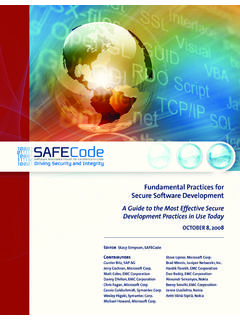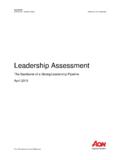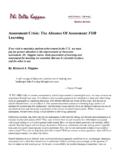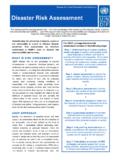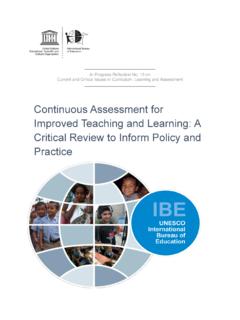Transcription of Dispositions assessment in teacher education: …
1 Research in Higher education Journal Dispositions assessment in teacher education : developing an assessment instrument for the college classroom and the field Gina Almerico The University of Tampa Pattie Johnston The University of Tampa Deanna Henriott The University of Tampa Mykel Shapiro The University of Tampa Abstract The purpose of the current study was to operationalize and validate terminology to be incorporated into a series of assessment tools to evaluate teacher candidate Dispositions . Researchers strived to develop a greater understanding of Dispositions being assessed in teacher education programs by identifying descriptors which clearly focus on the conceptual meaning of a given disposition .
2 Through a search of related literature and a series of interviews conducted by the research team, a series of instruments was developed to measure candidate Dispositions in the university classroom setting and in the field/clinical experience for teachers in training. Dispositions assessment , Page 1. Research in Higher education Journal Introduction A fundamental task of colleges and departments of teacher education is that of tracking, monitoring, and assessing candidate performance through their program. In recent years, in part due to external accreditation requirements, teacher education programs have been charged with the responsibility of assessing more than their candidates knowledge and skills in teaching.
3 The National Council for Accreditation of teacher education (NCATE) accreditation process as well as that of other professional organizations requires teacher preparation programs to develop appropriate assessment devices to measure and document candidate Dispositions . Because of this requirement, teacher education programs are exploring what is meant by Dispositions and investigating how they can be used and assessed. Defining Dispositions Dispositions related to effective teaching have been defined in a number of ways over the years. The National Council for Accreditation of teacher education (NCATE) (2001) provides the following explanation of Dispositions : Dispositions are the values, commitments, and professional ethics that influence behaviors toward students, families, colleagues, and communities that affect student learning, motivation, and development as well as the educator's own professional growth.
4 Dispositions , according to the NCATE, are steered by attitudes and beliefs related to values like caring, honesty, fairness, empathy respectfulness, responsibility, and thoughtfulness. NCATE, however, does not specifically define what elements compose target Dispositions . The Interstate New Teachers assessment and Support Consortium (INTASC) (1992) uses the following descriptors to encompass the concept of Dispositions : adopts, appreciates, believes, is committed, has enthusiasm, persists, realizes, recognizes, responds, seeks, is sensitive to, understands, and values. Taylor & Wasicsko (2000) define Dispositions as the personal qualities or characteristics that are possessed by individuals, including attitudes, beliefs, interests, appreciations, values, and modes of adjustments.
5 Schulte, Edick, Edwards, and Mackiel (2004). define disposition as a pattern of behavior exhibited frequently and in the absence of coercion, and constituting a habit of mind under some conscious and voluntary control, and that is intentional and oriented to broad goals. Why Assess Dispositions The importance of disposition assessment was stated by Broko, Liston, & Whitcomb (2007). They explain that Dispositions are an individual's tendencies to act in a given manner and are predictive of patterns of action. They answer the question of whether teachers are likely to apply the knowledge and skills they learn in teacher preparation programs to their own classroom teaching when they are not being critiqued.
6 One of the most difficult situations faced by teacher educators, according to Schulte, Edick, Edwards, and Mackiel (2004) is coming across teacher candidates who meet the requirements of content knowledge and pedagogical skills, yet lack the Dispositions essential to effective teaching. A teacher with the knowledge and skills to teach a particular content in particular ways is necessary but the possession of these knowledge and skills does not guarantee successful instructional implementation in the classroom. The manner in which the teachers' knowledge in shared with students, the way in which student learning is Dispositions assessment , Page 2.
7 Research in Higher education Journal facilitated or guided in an educational setting speaks to the importance of Dispositions assessment . To gain the whole picture of a candidates teaching effectiveness, one must consider all aspects of the teaching act. Educators have learned through the research that a strong correlation exists between the Dispositions of teachers and the quality of their students' learning (Notar, Riley, Taylor, Thornburg & Cargill 2009). Teachers who care about their students' academic achievements, those who are willing to exert the effort needed to ensure the classroom is a productive learning environment, have characteristics that may not be measured as possession of pedagogical knowledge and skills.
8 These are teachers, who are through their actions and demeanor, are demonstrating effective teaching Dispositions . Rike (2008) identifies the following purposes for disposition assessment in teacher education programs: Faculty need a way to clearly communicate to teacher candidates the expectations for their Dispositions and the means of assessment , Identifying and measuring Dispositions is a professional obligations in preservice teacher education , Creating and using a research-based document to measure Dispositions ensures consistency and limits subjectivity on the part of the evaluator.
9 Preservice teachers need to be aware that who they are and what they believe will have a long-term effect on their careers and the students they teach. Additional reasons for assessing teacher candidates' Dispositions include the following: Research (Wayda and Lund, 2005) indicates preservice teachers should know what is expected of them regarding Dispositions while enrolled in teacher education programs and how those Dispositions will be assessed, National exams and state licensure programs stress appropriate Dispositions as being as important to effective teaching as knowledge and skills, Preservice teachers need to know that Dispositions are as important as knowledge and skills in becoming an effective teacher (Taylor & Wasicsko, 2000)
10 , teacher candidates should begin to think of themselves as Teachers while in training and must be aware their Dispositions will be monitored and assessed throughout the program;. NCATE and other accrediting agencies require teacher education programs to monitor and assess candidate Dispositions . In addition, faculty in the education department in this study identified the need and wanted to develop a research-based instrument which could be used to relay to education majors the department's expectations for their Dispositions in both the university classroom and in the field. The disposition assessment developed will be used to track and monitor the student Dispositions as they move through the programs.












